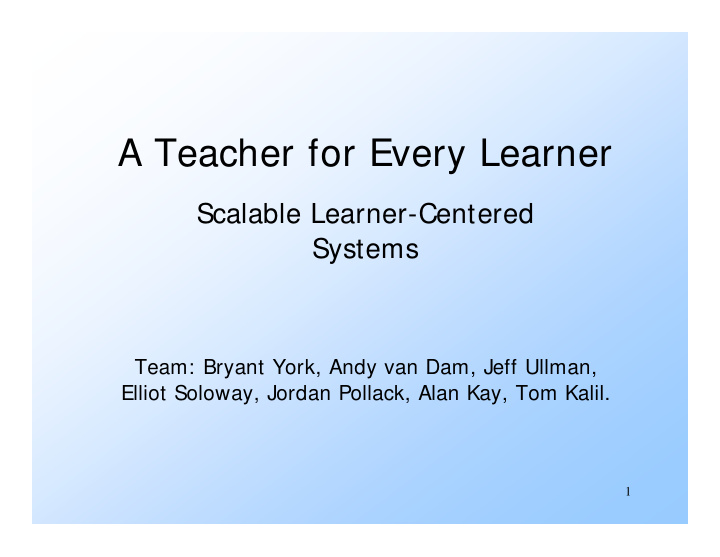



A Teacher for Every Learner Scalable Learner-Centered Systems Team: Bryant York, Andy van Dam, Jeff Ullman, Elliot Soloway, Jordan Pollack, Alan Kay, Tom Kalil. 1
20-Year Vision ! Information Technology enables all learners to participate in a network of communities, where they engage with other learners, mentors and teachers in self-expression, exploration, and learning by discovery and by doing ! The learning environment continuously assesses and adapts to each learner’s needs 2
The Social Challenge ! Create a universally well-educated citizenry that can adapt to a changing, global society " For economic growth " For social and personal well-being " US international leadership in education ! Greatly enhance all learners’ abilities to learn, and enjoyment of learning, over their lifetime " All levels of learners " Customization for learner’s needs " Learning to learn 3
Mission Informed by advances in learning sciences, pedagogical design, and assessment theory, lower the effective student-teacher ratio to 1:1 by building the technological infrastructure to support dynamic, ad-hoc communities of lifelong learners who interact within an environment of learning objects through a creative blend of advanced computing technologies, high performance networks, authoring and collaboration tools. 4
System View ! Components of the learning environment are human and virtual learners, teachers, mentors, colleagues, domain experts and tutors. ! Every learner is immersed in an environment consisting of multiple communities of learning and teaching entities connected via high-performance networks. ! The learning environment assesses each learner continuously and adapts to his/her needs transparently. ! Advanced authoring tools allow all participants to enhance the learning environment through the construction of both new learning objects and compositions of interoperable ones, including software agents and intelligent avatars. 5
Why has IT Not Yet Transformed Learning? ! Underinvestment " Less than 0.1% of total spending is spent for R&D in K-12 " Compares with 2-3% in mature industries, 10-25% in high- tech, life-sciences " $10/student/year for software in K-12 " Inadequate teacher training ! Inertia in social systems " More pressing social problems • Hunger • Homelessness • AIDS " Lack of parental involvement " Archaic notions of assessment " Intellectual property issues 6
Measurable Goals ! 1-Sigma improvement in Science-Technology- Engineering-Math performance by high-school graduation. " 1-1, live tutor demonstrated to yield 2-sigma. ! Every child reads effectively by 4 th grade. ! Average time-on-task increases by 20% ! High-school students graduate with the necessary information-technology fluency to hold a knowledge- intensive job. 7
Technical Challenges ! There are technical challenges in each of the following educational genres: 1. Cognitive tutors 2. Simulation-based, interoperable models 3. Massive-multiplayer-gaming 4. Collaborative authoring 5. Learning in context/mobile learning 8
Cognitive Tutors ! Example: PAT (algebra tutor) ! Reducing the cost of knowledge engineering ! Interoperability and reusability of models for students, experts, and the learning process ! Adaptive and self-improving systems 9
Simulation-Based Models ! Example: Now --- physics of motion; Future --- digital human ! Semantics of (model) interoperability " Extending component frameworks to support interoperability of models at multiple levels of sophistication • Discovery, negotiation, graceful degradation ! Modifiability and extensibility of models, while preserving acceptable fidelity " Scripting by nonprogrammers " Programming by domain-knowledgeable programmers 10
Massive-Multiplayer Gaming ! Example: Quake ! Capture the motivation of “twitch” and exploration gaming in educational software ! User-developed avatars/agents ! Scalability and performance for ad-hoc collaborations 11
Collaborative Authoring ! Example: SQUEAK ! Interface support for complex tasks (scaffolding) ! Smooth flow for collaborative tasks among learners ! Authoring/Scripting/Programming spectrum 12
Learning in Context and Mobile Learning ! Example: Probeware ! Designing for small form-factors ! Ad hoc dynamic learning paradigms " Dynamic matching of learner and tutor ! Impedance matching small mobile devices and large Scientific Instruments ! Large-scale data fusion 13
Summary ! Education has remained static for 800 years. It’s time to do something ! Information technology uniquely provides the means for transformation ! We need the social will, the investment, and our science to change the world of education ! Get involved! Help create a teacher for every learner 14
Recommend
More recommend